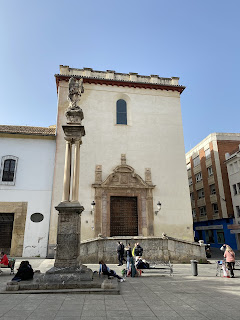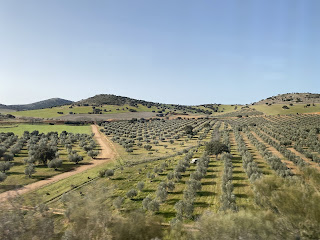I’m going to get the hard part out of the way first. I cried a lot today, well, this morning anyway. There’s something about this town that just manifests my sister, Joy. I don’t know why. As far as I know she was never particularly interested in Spain, although she knew the language well. She was much more French than anything else and spoke French fairly fluently, at one time. I’m convinced however, that she would have absolutely loved this town. From the streets to the culture to the tiny stores. Everywhere you turn there is history here and not just the kind that everyone sees and gravitates to in the touristy places, but deep, long history that isn’t uncovered by a brochure, but rather lived in the people who find this place home. As the day wore on however, I celebrated here spirit in this place remembering so much of what she loved and would love here.
If you thought my pictures of the Gothic Barrio in Barcelona or the Old Historic Center of Madrid were small and narrow. They have NOTHING on Cordoba.
Here’s a map of Cordoba.
These are just the main streets. All the important buildings are in brown with a corresponding red number. However, all the cream colored areas are packed with buildings and have tiny passages/streets that run through them or partially through them that are not on this map. And do you see anything like a city block? It’s very easy to get lost here. Try thinking, well I’ll just go so far, turn left, turn left and turn left again and I should come back to where I started, right? WRONG! Oh, but it is so worth it. There are beautiful buildings, shops, museums, churches, synagogues, and restaurants at every turn. Here are just a few.
And now for my food:
I had a Spanish Cheesecake for breakfast this morning. Of course, we all know our cheesecakes, right? There is the regular cheesecake baked or unbaked, and the New York Style Cheesecake which adds more cream cheese, cream and a few extra egg yolks. But this is something different.
As you can see, it is very flat and dense. I’ll need to look up recipes for this one to figure out what makes it so different. It is very cheesy and not creamy at all. I bought it yesterday at the fair and had it this morning with a cup of tea in the apartment.
My favorite meal thus far was today’s lunch at Bodega Mezquita. Oh gosh was it delicious! I had three tapas and a glass of local wine.
First a cold soup called Salmorejo - very common here in southern Spain. It is a cold very thick tomato soup, somewhat similar to gazpacho (also Spanish) but often with other vegetables and much thicker. The thickness and creaminess comes from adding soaked bread, then topped with ham and hard boiled eggs.
Second tapas was meatballs and fried potatoes. My sister used to make a meatloaf with ground turkey, quinoa, diced vegetables and spices. These meatballs were very similar to her meatloaf in taste and texture, but they were made with ground beef, almonds, and saffron.
Third was Oxtail Croquettes. My grandmother used to make chicken croquettes for us when my sister and I would go to her house and stay overnight, which was pretty much the only time I ever had croquettes. It wasn’t until I was much older that I find out that she didn’t actually make them. She bought them at the store, frozen. I loved them when I was little thinking how special my sister and I were that she spent so much time making them. LOL. Sorry, grandma, although your frozen croquettes were great, these croquettes were amazing!
And some bread: It was a thick sunflower seed cracker:
I’ve found that I just can’t eat dinner here most of the time. In fact, I’ve pretty much only had two meals most days as I’m not that hungry AND the Spanish time schedule for meals is so foreign to my own. The day starts around 10, lunch starts around 2 and restaurants don’t even open for dinner until 8pm. So, I have a late-ish breakfast and try to hold off until 3 for lunch/dinner. The other thing is that Spaniards spend hours at a meal. The wait staff are in absolutely no hurry to get you in, seated, waited upon, food delivered, and brought your check - all as quickly as possible. Instead, they bring you free tapas (usually small pieces of bread with tomatoes/olives and ham or bread and cheese), and a drink. Then they wait about 20-30 minutes before asking if you’d like to order off the menu. Finally, when the meal comes and you are finished, they expect you to have another drink, dessert or coffee. It really isn’t until you’ve been sitting and done eating for about an hour that they bring the check. And, for me, that has only come with some asking. So my 3 o’clock lunch usually ends around 5pm - which for me is lunch/dinner. I kind of like the much slower pace, but it takes some getting used to.
I offer this quote that my friend Vivian sent me: it is so appropriate for my focus and the slower pace of meals here in Spain.
“We drink and eat all the time, but we usually ingest only our ideas, projects, worries and anxiety. We do not really eat our bread or drink our beverage. If we allow ourselves to touch our bread deeply, we become reborn, because our bread is life itself. Eating it deeply, we touch the sun, the clouds, the earth and everything in the cosmos. We touch life, and we touch the Kingdom of God…the body of Christ is the body of God, the body of ultimate reality, the ground of all existence. We do not have to look anywhere else for it. It resides deep in our being. The Eucharistic rite encourages us to be fully aware so that we touch the body of reality in us. Bread and wine are not symbols. They contain the reality, just as we do.” -Thich Nhat Hanh, from Living Buddha, Living Christ
At the end of the day, I refreshed my physical, psychological, and spiritual body with a trip to the local Hammam. I read all they were doing for COVID-19 protocols and felt safe to go. Indeed, it was quiet, ritualistic, and refreshing. A one-hour massage followed by time in the warming pool, the hot pool, the cold pool and the steam room - in that order as directed. My tired feet, aching knee, hips and back feel ready to walk another 75 miles!
Tomorrow I tour the mosque that was built over a church that was then turned back into a church. Again, there’s LONG history here. I will also tour the synagogue and the Alcazar, the primary residence of Isabella I and Ferdinand when they conquered the area in the late 15th/early 16th Century.




















































